红字中的象征
浅谈《红字》中象征主义的用法

浅谈《红字》中象征手法的运用摘要:霍桑的《红字》自问世至今,一直受到广大读者和评论家的青睐。
小说充分体现了霍桑象征主义手法运用的高超技艺,本文对象征手法进行了剖析。
关键词:象征原罪红字A美国文艺复兴时期的著名作家霍桑,深受清教意识、超验哲学和神秘主义影响,他的代表作《红字》自问世至今,一直受到广大读者和评论家的青睐。
小说充分体现了霍桑象征主义手法运用的高超技艺,通过这一表现手法,他的行文摇曳多姿,引而不露,含而不发,耐人寻味。
一、在人物描写中运用象征手法小说中,霍桑在刻画人物时便赋予了他们深刻的寓意。
罗杰・奇林沃斯,这一邪恶的清教徒形象的最大特点是伪善和狠毒。
这个外表消瘦,畸形的老人在一个受人尊敬的“医生”的身份的伪装下,以治病抚伤为由,秘密地进行着复仇活动,一步步地偷窥,挖掘着人内心的秘密,慢慢地摧毁人的灵魂。
他为了满足自己的私欲,心安理得地将海丝特的青春占有,当发现自己妻子的背叛之后,为了报仇,他像一条毒蛇一样缠住狄梅斯迪尔不放,竭尽折磨狄梅斯迪尔的灵魂。
他虚伪地以“一个最可信赖的朋友”的面目出现,哄骗狄梅斯迪尔将“一切的恐怖、惭愧、痛苦、无效的悔恨、无法摆脱的内心谴责,都要对他和盘托出!”而他内心却是“绝无怜悯,绝无容赦!'”在海丝特与罗杰的谈话中,罗杰曾说:“我的手指只要对他一指,便会将他从他的讲坛弹到大牢里去,说不定还要上绞刑台呢!”这个阴险的小人自认为手中的强大力量正是当时教会的暴虐,严峻的统治。
珠儿是小说中极具神秘色彩的一个人物,她纯洁无邪,敏捷灵巧,却生来就要承受“恶魔之女”的罪名,她是性“罪过”的有形产物。
她的存在时时刻刻让人想起海丝特的“罪过”。
然而,珠儿对于海丝特而言,更是上帝对她莫大的恩赐。
珠儿是她美好爱情的结晶,代表着纯洁,她的名字象征着高贵。
因此,珠儿象征着海丝特承受罪过的极大勇气和激情。
二、红字A的象征意义霍桑对红字A的多种象征意义贯穿于全书中,赋予了它丰富多样的象征意义,从不同角度不同层次审视,出现不同或完全相反的象征意义。
浅析《红字》中的字母A象征
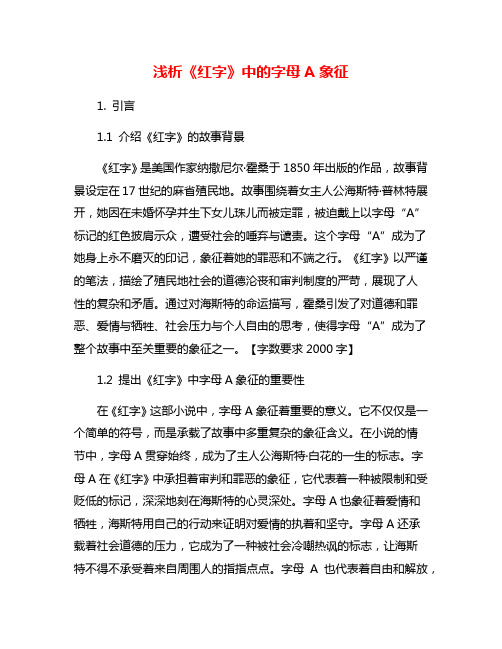
浅析《红字》中的字母A象征1. 引言1.1 介绍《红字》的故事背景《红字》是美国作家纳撒尼尔·霍桑于1850年出版的作品,故事背景设定在17世纪的麻省殖民地。
故事围绕着女主人公海斯特·普林特展开,她因在未婚怀孕并生下女儿珠儿而被定罪,被迫戴上以字母“A”标记的红色披肩示众,遭受社会的唾弃与谴责。
这个字母“A”成为了她身上永不磨灭的印记,象征着她的罪恶和不端之行。
《红字》以严谨的笔法,描绘了殖民地社会的道德沦丧和审判制度的严苛,展现了人性的复杂和矛盾。
通过对海斯特的命运描写,霍桑引发了对道德和罪恶、爱情与牺牲、社会压力与个人自由的思考,使得字母“A”成为了整个故事中至关重要的象征之一。
【字数要求2000字】1.2 提出《红字》中字母A象征的重要性在《红字》这部小说中,字母A象征着重要的意义。
它不仅仅是一个简单的符号,而是承载了故事中多重复杂的象征含义。
在小说的情节中,字母A贯穿始终,成为了主人公海斯特·白花的一生的标志。
字母A在《红字》中承担着审判和罪恶的象征,它代表着一种被限制和受贬低的标记,深深地刻在海斯特的心灵深处。
字母A也象征着爱情和牺牲,海斯特用自己的行动来证明对爱情的执着和坚守。
字母A还承载着社会道德的压力,它成为了一种被社会冷嘲热讽的标志,让海斯特不得不承受着来自周围人的指指点点。
字母A也代表着自由和解放,海斯特最终通过接受自己的内心,勇敢地去面对社会的压力,实现了内心的真正解放。
字母A在《红字》中是一个多维度的象征,代表着人物内心的复杂情感和社会议题。
2. 正文2.1 字母A在小说中的不同形式和含义在小说《红字》中,字母A以多种形式出现,并且具有不同的含义。
字母A在小说中代表了亵渎和罪恶。
当海斯特·品彻利夫被发现与哈娜·皮特向通奸时,她被迫戴上一块红色的字母A,以示她的罪行。
这个字母成了她生活中无法逃避的标记,让她承受着来自社会的压力和歧视。
论霍桑《红字》中的象征手法

论霍桑《红字》中的象征手法摘要:美国著名作家霍桑的《红字》被称为美国第一部象征主义小说,在这部优秀的作品中,作者运用了丰富的象征手法,深化了小说的主题,增强了作品的感染力以及表现力。
对于作者如何熟练地运用象征手法,值得我们深入探讨。
本文主要从红字“A”、场景、人物、人物名字、鲜花等方面,对象征手法的运用进行分析,旨在为相关研究者提供借鉴。
关键词:《红字》霍桑象征手法寓意霍桑是美国浪漫主义作家之一,其长篇小说《红字》发表于1850年。
1848年正好在纽约召开了美国第一届妇女权利大会,会上提出了男女平等、财产权等问题。
因此,这部长篇小说内容涉及婚外情以及激进的女性主义思想,大胆地挑战和颠覆了当时基督教的价值判断。
与此同时,霍桑《红字》中运用的象征手法,不仅对许多作家作品的创作产生了重要影响,同时还影响了现代派文学的象征主义。
此外,在现代作品创作过程中,对霍桑《红字》象征手法的分析进行探讨,对我国现代文学的发展具有重要的现实意义。
一、象征主义和象征手法概述象征主义一词源于希腊文,原意并不是指象征主义,几经演变以后,被引申为可以用某种观念或事物代表符号或者物品。
在文学界,“象征主义”这个名称第一次是出现在1886年诗人让·莫雷亚斯发表的《象征主义宣言》中,也标志着象征主义流派的产生。
实际上,象征主义在未被提出之前,许多作家在作品中就大量运用象征主义这种创作方法。
象征派主张创作作品不要直接、客观、如实地描写所见事实,而是通过利用特定形象,表达作者的精神世界以及观念。
19世纪末,英国发生了文学艺术活动,扩大了象征主义的影响,推动了20世纪美学的发展。
象征主义不仅被运用到文学界,还应用到戏剧、绘画等创作中。
在文学界,象征手法是创作的一种重要手法,主要是借助某种具体形象来表现思想情感。
在文学创作中,恰当地运用象征手法,可以使作品立意深远、主题深刻,给读者留下咀嚼回味的空间。
霍桑所创作的《红字》,大量运用了象征的手法,有比较明显的象征,也有许多隐晦的象征,其对象征手法的运用影响了《白鲸》的作者麦尔维尔、法国的波德莱尔,而且影响了一批美国卓有成就的作家,如海明威、菲兹杰拉德、福克纳等。
浅谈《红字》中的象征主义
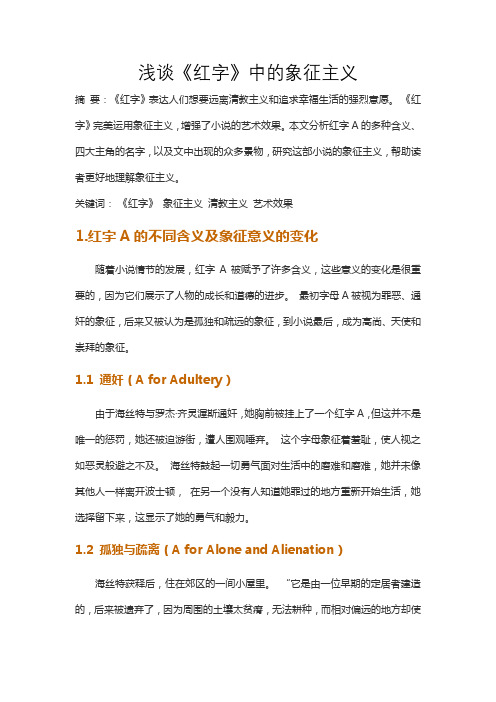
浅谈《红字》中的象征主义摘要:《红字》表达人们想要远离清教主义和追求幸福生活的强烈意愿。
《红字》完美运用象征主义,增强了小说的艺术效果。
本文分析红字A的多种含义、四大主角的名字,以及文中出现的众多景物,研究这部小说的象征主义,帮助读者更好地理解象征主义。
关键词:《红字》象征主义清教主义艺术效果1.红字A的不同含义及象征意义的变化随着小说情节的发展,红字A被赋予了许多含义,这些意义的变化是很重要的,因为它们展示了人物的成长和道德的进步。
最初字母A被视为罪恶、通奸的象征,后来又被认为是孤独和疏远的象征,到小说最后,成为高尚、天使和崇拜的象征。
1.1 通奸(A for Adultery)由于海丝特与罗杰·齐灵渥斯通奸,她胸前被挂上了一个红字A,但这并不是唯一的惩罚,她还被迫游街,遭人围观唾弃。
这个字母象征着羞耻,使人视之如恶灵般避之不及。
海丝特鼓起一切勇气面对生活中的磨难和磨难,她并未像其他人一样离开波士顿,在另一个没有人知道她罪过的地方重新开始生活,她选择留下来,这显示了她的勇气和毅力。
1.2 孤独与疏离(A for Alone and Alienation)海丝特获释后,住在郊区的一间小屋里。
“它是由一位早期的定居者建造的,后来被遗弃了,因为周围的土壤太贫瘠,无法耕种,而相对偏远的地方却使它脱离了已经标志着移民习惯的社会活动的范围”(75)。
由于她的罪行,海丝特几乎没有社交生活,在某种程度上已经与世界疏远了。
人们讨厌海丝特,不愿与她接触。
显然,红字A象征着孤独和疏离。
1.3 能力、钦佩和天使(A for Ability,Admiration and Angel)随着时间的流逝,红字A逐渐转变为能力(Ability)、钦佩(Admiration)和天使(Angel)的象征。
那些因为海丝特的罪恶而责备她的人逐渐改变了对她的看法:“红字A代表着她精巧的针线活能力,以及她对急需帮助的人付出的爱心。
《红字》中的“A”

《红字》中的“A”《红字》是美国作家纳撒尼尔·霍桑所写的一部小说,讲述了一个女人因婚外恋而被社会指责和惩罚的故事。
在小说中,字母“A”具有重要的象征意义,代表着“罪”和“羞耻”。
小说的故事背景设定在17世纪的美国,当时信仰基督教对人们的生活产生了巨大的影响。
女主人公海丽斯·普林是一个美丽而优雅的女人,她婚后与一位年轻的神职人员阿瑟·德姆斯代尔发生了婚外恋。
他们的爱情被发现后,海丽斯被判定有罪,并被刺上她犯罪的标志——一枚红色的字母“A”(即Adultery,通奸的意思)。
在整个小说中,红色的字母“A”成为了海丽斯的标志,并象征着她所犯下的罪行和社会对她的谴责。
海丽斯将这个字母缝在自己的衣服上,公开承认自己的罪行,并接受社会的谴责和惩罚。
这个红色的字母成为了她的身份认证,也成为了她无法逃避的羞耻的象征。
尽管海丽斯感到痛苦和羞耻,但她并没有选择逃避或否认自己所犯下的罪行。
相反,她勇敢地面对自己的错误,并在社会的监视下过上了孤独和耻辱的生活。
她尝试改变自己的内心,通过帮助他人来弥补她的过失,但这并不能改变社会对她的看法。
通过描绘海丽斯的遭遇,霍桑探讨了道德、罪与赎罪的主题。
小说中的“A”不仅仅是一种标记,它还象征着社会对犯罪的谴责和个人内心的挣扎。
海丽斯通过接受这个字母,实际上也接受了自己内心的罪恶。
《红字》在揭示人类本性方面具有深刻的洞察力。
虽然海丽斯所犯下的过错是一种背叛,但她并非一个完全邪恶的人物。
她是一个复杂的角色,纠结于人性的弱点和欲望之间。
小说通过描绘她的故事,引发读者对道德和人性的思考,并揭示了社会对罪行和赎罪的不公正和残酷。
《红字》中的“A”是一个强烈的象征,它代表着海丽斯所犯下的罪行和社会对她的谴责。
通过这个象征,霍桑揭示了人类欲望和道德之间的冲突,并引发了关于罪与赎罪的深思。
这部小说以其深入的洞察力和对人性的揭示而成为经典之作。
《红字》中红字“A”的不同象征意义
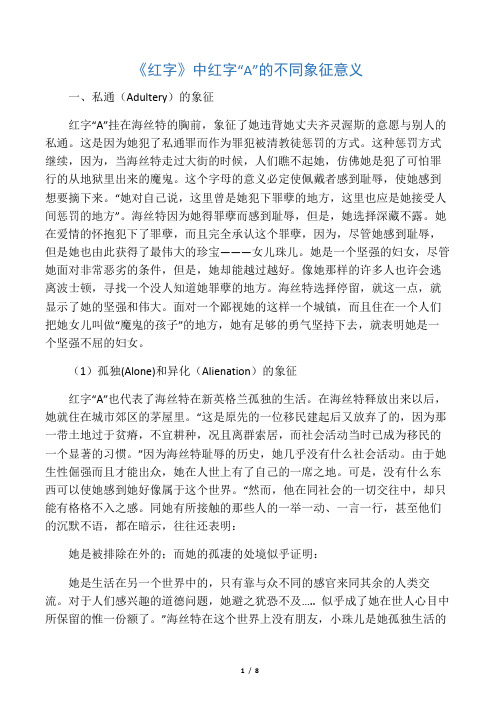
《红字》中红字“A”的不同象征意义一、私通(Adultery)的象征红字“A”挂在海丝特的胸前,象征了她违背她丈夫齐灵渥斯的意愿与别人的私通。
这是因为她犯了私通罪而作为罪犯被清教徒惩罚的方式。
这种惩罚方式继续,因为,当海丝特走过大街的时候,人们瞧不起她,仿佛她是犯了可怕罪行的从地狱里出来的魔鬼。
这个字母的意义必定使佩戴者感到耻辱,使她感到想要摘下来。
“她对自己说,这里曾是她犯下罪孽的地方,这里也应是她接受人间惩罚的地方”。
海丝特因为她得罪孽而感到耻辱,但是,她选择深藏不露。
她在爱情的怀抱犯下了罪孽,而且完全承认这个罪孽,因为,尽管她感到耻辱,但是她也由此获得了最伟大的珍宝———女儿珠儿。
她是一个坚强的妇女,尽管她面对非常恶劣的条件,但是,她却能越过越好。
像她那样的许多人也许会逃离波士顿,寻找一个没人知道她罪孽的地方。
海丝特选择停留,就这一点,就显示了她的坚强和伟大。
面对一个鄙视她的这样一个城镇,而且住在一个人们把她女儿叫做“魔鬼的孩子”的地方,她有足够的勇气坚持下去,就表明她是一个坚强不屈的妇女。
(1)孤独(Alone)和异化(Alienation)的象征红字“A”也代表了海丝特在新英格兰孤独的生活。
在海丝特释放出来以后,她就住在城市郊区的茅屋里。
“这是原先的一位移民建起后又放弃了的,因为那一带土地过于贫瘠,不宜耕种,况且离群索居,而社会活动当时已成为移民的一个显著的习惯。
”因为海丝特耻辱的历史,她几乎没有什么社会活动。
由于她生性倔强而且才能出众,她在人世上有了自己的一席之地。
可是,没有什么东西可以使她感到她好像属于这个世界。
“然而,他在同社会的一切交往中,却只能有格格不入之感。
同她有所接触的那些人的一举一动、一言一行,甚至他们的沉默不语,都在暗示,往往还表明:她是被排除在外的;而她的孤凄的处境似乎证明:她是生活在另一个世界中的,只有靠与众不同的感官来同其余的人类交流。
对于人们感兴趣的道德问题,她避之犹恐不及…‥似乎成了她在世人心目中所保留的惟一份额了。
浅谈小说《红字》中的多重象征意义

浅谈小说《红字》中的多重象征意义纳尼尔·霍桑是美国19世纪伟大的浪漫主义小说家。
他的长篇小说《红字》是其最杰出的代表作。
霍桑在小说中多次运用象征手法,从而使小说中的人物、场所、其它景物以及贯穿小说始终的红字A都带上了特殊的象征意义。
该小说深刻剖析了罪与罚的宗教意识以及其对人性道德本质的深刻影响。
标签:《红字》“A”人物;场景;象征意义1.红字“A”的象征意义1.1霍桑在《红字》中用了大量的象征,小说以“A”开头又以“A”结尾,全部内容包含在这个字母中,人物的命运,情节的发展都与之息息相关,所以红字“A”代表了小说本身。
象征意义最为典型的红字“A”,顾名思义是红色的 A 字,首先映入我们眼帘的便是耀眼的红色。
红色是一种能引起人们无限联想的颜色,于是小说中红色展示出了各种丰富的内涵:红色是血与火的颜色,是热烈情欲的象征,海丝特和丁梅斯代尔抑制不住青春的冲动和对对方的爱慕,最終成为上帝的罪人,一个妇女丧失了贞节,一位牧师辱没了自己的使命,受到惩罚。
红色还是生命、力量和热情的象征。
海丝特与丁梅斯代尔之间的爱情是纯洁的,美丽的,热烈的,然而在严峻的清教思想的统治下,象征爱情和生命之源的红色被愚昧的社会当作耻辱的标记戴在海丝特胸前,以示惩戒。
让大家觉得讽刺的是:海丝特胸前耀眼的红字,就如同她心头熊熊燃烧着的一团火焰,在严寒和冷酷的社会环境中带给她温暖;在死一般地孤独和寂寞中给她以生的希望和勇气。
虽然遭到社会的迫害,世人的唾弃,她却没有屈服,她几乎是昂首挺胸走出层层困境,以无声地沉默和坚强的信念反抗着令人感到窒息的精神压迫。
她坚定地相信,一个更光明的时期一定会来临,人们将会获得真正的爱情和幸福。
1.2就红字“A”本身而言,它并没有神秘的色彩,第一次出现在人们面前,它仅仅是一个耻辱的符号,A字是通奸(Adultery)的缩写,作者霍桑是这样对它进行描述的:“在她(海丝特)衣服的胸部,出现 A 形的字,那是精美的红布制成的,四周有金线织成的细工刺绣和奇巧花样。
《红字》中象征主义手法的运用分析

《红字》中象征主义手法的运用分析
《红字》是中国著名诗人李清照的一首词,以赤字无助地被抛弃为主题。
文中,作者利用象征手法,来讽刺那些贪财无度的奢侈之人,又把人性的短处暴露于众。
一、写实主义手法:文中写出被抛弃的“红字”,这个“红字”本来可以象征情书或者爱国热情,但作者写出却是“穷苦人家”把它当成“士多啤梨”来供养家。
这种写实之作,与抛弃的“红字”的象征性有较大的矛盾,深刻地揭示了当今人性的贪婪情绪,即“以物易物”,无情地把破烂衣服等“红字”卖给乞丐。
二、山水象征法:李清照在词中穿插山水景象,以打动读者的情感。
他提到巴陵“泻入清溪,晴天变月”,仿佛山水在夕阳的余辉中,却隐含着那些被抛弃的“红字”的无奈与悲凉,他又写道“未到桃花谷,却自芦苇林”,象征被抛弃的“红字”早早的失去了属于自己的求爱之情,已经永远不能靠近桃花谷之处。
三、寓言手法:寓言手法在词中运用较多,作者用离奇的象征与拟人化,让读者比较容易理解作者所暗示的人性本质之薄弱。
“闲花重叠,求爱不择”,把“红字”的求爱喻成闲花的落叶,说明当年原本有多緿荣的爱情,但是被他人贪恋,结果只有夹杂着哀凉的“红字”抛弃于门前。
“一旦随风去,何日复归?”,把“红字”喻成飘动的“风”,暗示着那些因贪念而失去了的感情,是永远也不能挽回的。
通过《红字》这首词,李清照利用着象征主义手法,深刻地揭示了贪心和无情的人性本质,又让人们深深地反省自己的一些不正确的行为。
《红字》中的象征主义

《红字》中的象征主义作者:导师:摘要《红字》是十九世纪美国著名的浪漫主义小说家霍桑的代表作,他常把自己的著作看作浪漫作品而不是小说。
《红字》突出的艺术特色是其丰富的象征手法,因此被称为美国历史上第一部象征主义小说。
作者以红字“A”为线索,通过女主人公海丝特的悲惨遭遇,深刻揭露了新英格兰时期清教殖民统治的社会现状。
本文拟通过对刑台、一系列黑色意象、人物和红字“A”这几个具有象征意义的意象的分析,揭示出象征主义这一艺术特色在全书中的作用和蕴涵的深意,从而能更好地理解全书的主旨。
关键词:象征主义,清教徒,意象,通奸罪Symbolism in The Scarlet LetterAuthor:Supervisor:ABSTRACTThe Scarlet Letter is the masterpiece of the well known romantic novelist, Nathaniel Hawthorne, in America in the 19th century. He often calls his works as a romance rather than a novel. Symbolism is the conspicuous artistic characteristic of The Scarlet Letter; therefore, it is also regarded as the first symbolic novel in the history of American fiction. Hawthorne uses the letter A as a clue to represent the society in New England, which is under the control of Puritans. In this article, several symbolic images, such as the scaffold, a series of ―Black‖ images, characters and the scarlet letter ―A‖, are analyzed, and the function and the hinted meaning of symbolism are made clear, so it leads to a better understanding of the theme of the book.Key words: symbolism, Puritan, image, adulteryAcknowledgementsCONTENTS摘要 (Ⅰ)Abstract (Ⅱ)1 In t rod u c ti on (1)2 Different Meanings of the Scarlet Letter “A” (3)2.1 Adultery (3)2.2 Alone and Alienation (3)2.3 Able, Admirable and Angel (4)2.4 Biblical Archetype (4)3 Symbolic Meanings of the Four Major Characters' Names (7)3.1 Hester Prynne (7)3.2Arthur Dimmesdale (8)3.3 Roger Chillingworth (9)3.4 Pearl (10)4 Symbolic Meanings of the Objects Described in the Novel (13)4.1 Light and Darkness (13)4.2 Prison (14)4.3 Rose Bush (14)4.4 Forest (15)5 Conclusion (16)References (17)1 IntroductionNathaniel Hawthorne is considered to be one of the greatest of American fiction writers. Hawthorne‘s lifelong fascination with New England social and religious history derived in part from his own family background. He was forced by poor finances to accept a post as surveyor in the Salem Custom House, a position he lost in 1849. Troubled about money and saddened by the recent death of his mother, Hawthorne began a novel that he had brooded over for years. As a result, Hawthorne is frequently credited with portraying Puritanism in The Scarlet Letter in a remarkably authentic and convincing manner.The intention of this study is to know what is symbol, and what is symbolism, and we are going to know the m from Hawthorne‘s use of symbols in The Scarlet Letter. Generally speaking, a symbol is anything which is used to represent something other than itself. In literature it is most often a concrete object which is used to represent something broader and more abstract-often a moral, religious, or philosophical concept or value. Symbols range from the most obvious and mechanical substitution of one thing for another, to creations as massive, complex, and perplexing as Melville‘s white whale in Moby Dick.As we know i t is in Hawthorne‘s use of symbols in The Scarlet Letter that he has made one of his most distinctive and significant contributions to the growth of American fiction. Indeed, this book is usually regarded as the first symbolic novel to be written in the United States.We are going to make a study in the different meanings of the scarlet ―A‖, the symbolic meaning of the four major character s‘name and the symbolic meanings of the objects described in the novel.Also, we would know from the study that Hawthorne was not a realist, but a symbolic novelist. Or, to put it in his own terms, he was writing not a ―novel‖ but a ―romance‖.He feels free to select both from the village and from the countryside which surrounds it, those details which will best help him to set the mood and convey the ideas of his ―romance‖. It is because they are helpful to him that he has used the scaffold, the forest, the rosebush, Mistress Hibbins, Governor Bellingham, the Election Sermon, the drab and solemn townspeople, and even the period itself. By allowing himself this latitude in his choice of details, he hascertainly been able to bring out or mellow the lights and deepen and enrich the shadows of The Scarlet Letter.And definitely, we would know the artistic characteristic—symbolism in The Scarlet Lette r from this study. We absolutely have a better understanding of the theme of the book through the analysis, the function and the hinted meaning of symbolism.2 Different Meanings of the Scarlet Letter "A"In this novel, the scarlet letter "A" changes its meaning many different times. This change is significant. It shows growth in the characters, and the community in which they live. The letter "A" begins as a symbol of sin. It then becomes a symbol of alone and alienation, and finally it becomes a symbol of able, angel and admirable.2.1 AdulteryThe letter "A", worn on Hester's bosom, is a symbol of her adultery against Roger Chilling worth. This is the puritan way of treating her as a criminal, for the crime of adultery. The puritan treatment continues, because as Hester walks through the streets, she will be looked down upon as if she is some sort of demon from hell that commits a terrible crime.This letter is meant to be worn in shame, and to make Hester feel unwanted. ―Here, she said to herself, had been the scene of her guilt, and here should be the scene of her earthly punishme nt…‖(Hawthorn,1998:74).Hester is ashamed of her sin, but she chooses not to show it. She commits this sin in the heat of passion, and fully admits it because, though she is ashamed, she also receives her greatest treasure, Pearl, out of it. She is a very strong woman to be able to hold up so well against what she must face. Many will have fled Boston, and seek a place where no one knows of her great sin. Hester chooses to stay though, which shows a lot of strength and integrity. Any woman with enough nerve to hold up against a town, which despises her very existence, and to stay in a place where her daughter is referred to as a "devil child," either has some sort of psychological problem, or is a very tough woman.2.2 Alone and AlienationThe scarlet letter "A" also stands for Hester's lonely life in New England.After she is released, Hester lives in a cottage near the outskirts of the city. "It had been built by an earlier settler, and abandoned, because the soil about it was too sterile for cultivation, while its comparative remoteness put it out of the sphere of that social activity which already marked the habits of the emigrants‖ (Hawthorn,1998:75). Hester's social life is virtually eliminated as a result of her shameful history. Hester comes to have a part to perform in the world with her native energy of character and rare capacity. However, there was nothing that made her feel as if she belonged to it. Every gesture, every word, and even thesilence of those with whom she came to contact, implied, and often expressed, that she was banished, and as much alone as if she inhabited another sphere, or communicated with the common nature by other organs and senses than the rest of human kind.She stood apart from moral interests… ―seemed to be the sole portion that she retained in the universal heart‖(Hawthorn, 1998:78). Hester has no friends in the world, and little Pearl is the only companion of her lonely life, so the scarlet letter ―A‖ also is a symbol of the words ―alone‖ and ―alienate‖.2.3 Able, Admirable and AngelLat er, the scarlet letter ―A‖ changes its meaning into being able, angel and admirable. The townspeople who condemned her now believe the scarlet letter to stand for her ability to her beautiful needlework and for her unselfish assistance to the poor and sick. ―The letter was the symbol of her calling. Such helpfulness is found in her so much power to do and power to sympathize - that many people refuses to interpret the scarlet letter ‗A' b y its original signification‖(Bell, 1971:148). At this point, a lot of the townspeople realize what a noble character Hester possesses.―Do you see that woman with the embroidered badge? It is our Hester – the town's own Hester –who is so kind to the poor, so helpful to the sick, so comforting to the afflicted!‖(Hawthorn,1998:149). The townspeople soon begin to believe that the badge served to ward off evil, and Hester grows to be quite admirable amongst the people of the town. Hester overcomes the shame of her sin through the purity and goodness of her soul. Unselfishly offering her time and love to those who need her most proves that she is not worthy of the fate which has been dealt to her.The three changes in the scarlet letter are significant; they show the progressive possession of her sin, her lonely life, and her ability. Hester is a strong admirable woman who goes through more emotional torture that most people go through in a lifetime.2.4 Biblical ArchetypeThe scarlet letter "A" also can be seen the symbol of Adam. It tells us that Hester's sin is the original sin of human being, it is forgivable.The writer shows his sympathy by describing the scarlet letter "A" on Hester's clothing as an ornament and a decoration. Hester's making the scarlet letter "A" into a thing of beautyoffends many bystanders, who comment that, "it were well if west ripped Madame Hester's rich gown off her dainty shoulders"(Hawthorn, 1998:51).However, as a young woman observes, "not a stitch in that embroidered letter, but she has felt it in her heart" (Chen Suying, 1997:21). The feeling of sympathy, only expressed by one of the characters throughout this scene, is used by Hawthorne to criticize the puritans for their strictness. The society is too strict in its ways, and Hawthorne shows his contempt for the treatment of Hester by constantly reinforcing how cruelly the people talk about her. Hawthorne says at the end of Chapter One," Finding it (rosebush) so directly on the threshold of our narrative, which is now about to issue from that inauspicious portal, we could hardly do otherwise than pluck one of its flowers, and present it to the reader. It may serve, let us hope, to symbolize some sweat moral blossom, that may be found alone the track, or relieve the darkening close of a tale of human frailty and sorrow"(Hu Shangtian, 1999:23). This kind of sympathy can be seen in the novel everywhere.To Hester, the scarlet letter "A" also stands for her lover, Pearl's father, Arthur Dimmesdale. Her fantastically embroidering the scarlet letter "A", which means adultery, is somehow a way she shows her passion for Arthur.Her refusing to tell the name of Pearl's father is a way to protect him.Her choosing to remain in New England after she is released is because it is the place where her lover stays. " There dwelt, there trod the feet of one with whom she deemed herself connected in a union, before the bar of final judgment, and make that their marriage-alter, for a joint futurity of endless retribution"(Hawthorn,1998:74). She wears the scarlet letter for seven years, and misses her lover in this way. Only when she meets Arthur again in the forest seven years later, deciding to flee to somewhere else, does she throw the scarlet letter away. After Dimmesdale's death, Hester and Pearl disappear for several years. Despite living with her daughter, Hester comes back to live the rest of her life in her cottage again, and picks up the scarlet letter for the third time. To Hester, there is a more real life in New England than in that unknown region where Pearl has founded a home."Here had been her sin, here, her sorrow, and here was yet to be her penitence" (Hawthorn, 1998:238). Moreover, here is where her lover lies. Hester eventually dies and is buried in the King's Chapel Cemetery. " It was near that old and sunken grave, yet with aspace between, as if the dust of the two sleepers had no right to mingle. Yet one tombstone served for both."--- " ON A FIELD, SABLE, THE LETTER, GULES"(Hawthorn, 1998:240).3 Symbolic Meanings of the Four Major Characters' NamesIn addition to the scarlet letter ―A‖, there are four major characters‘ names which have abundant symbolic meanings.3.1 Hester PrynneHester Prynne is one of the major characters in The Scarlet Letter.The writer gives her much symbolic meaning by giving her this name. Hester sounds like Hestier, Zeus' sister in Greek mythology, who is a very beautiful goddess. This gives us a sense that Hester is a passionate beautiful woman.In this novel, she is the symbol of the truth, the goodness and the beauty.Nathaniel Hawthorne describes her in Chapter Two like this: "The young woman was tall, a figure of perfect elegance on a large scale, she had dark and abundant hair, so glossy that it threw off the sunshine with a gleam, and a face which, besides being beautiful from regularity of feature and richness of complexion, had the impressiveness belonging to a marked brow and deep black eyes…"(1998:50). For so many years, Hester refuses to speak out the name of her partner in sin, but takes over all the punishment by herself. Instead of running from the hostile colonists, Hester withstands their insolence and pursues a normal life. She proves her worth with her uncommon sewing skills and provides community service. Hester's own sin gives her "sympathetic knowledge of the sin in other hearts." Even though the people she tries to help "often reviled the hand that was stretched forth to succor them," she continues her services because she actually cares. At last, the colonists come to think of the scarlet letter as "the cross on a nun's bosom", which is not small accomplishment.Also, Hester is the homophone of the word haste. At first, she gets married to Roger Prynne, an ugly man who gives his best years to feed the hungry dream of knowledge. Not having got the news about her husband who should have arrived by ship from England, she falls love with Arthur hastily and gives birth to Pearl, for which she is condemned to wear on the breast of her gown the scarlet letter "A", which stands for adultery. But Hester's adultery haste is nothing but a very natural thing to do. In the Holy Bible, Adam and Eve, the very ancestors of human being, who live in the Garden of Eden, eat the fruit of the tree that is in the middle of the garden tricked by the serpent. After that, they begin to know good and evil,and also they begin to know sex. Adultery is nothing but the original sin of human being. God's punishment to them is just sending them forth from the Garden of Eden. But in The Scarlet Letter, Hester is tortured physically and mentally for her sin. Hester says to Dimmesdale in the forest later, ―What we did had a consecration of its own, we felt so!‖(Hawthorn, 1998:179). In essence, their sin is no worse than Adam and Eve's. The punishment of puritan society is somehow too hard on a woman who is led by human instinct.3.2 Arthur DimmesdaleArthur Dimmesdale is a well-regarded young minister, whose initials are AD, which also stands for adultery. The author obviously tells us Author Dimmesdale is the partner in sin of Hester Prynne by giving him this name.The word Dimmesdale also has many symbolic meanings. Dim means dark and weak, and dale means valley, so the dimmesdale here is actually a symbol of the "dim-interior" of the clergyman. He loves Hester deeply, and he is the father of Pearl, but he can only show his passion for her in the forest or in darkness. His response to the sin is to lie. He stands before Hester and the rest of the town and proceeds to give a moving speech about how it would be in her and the father's best interest for her to reveal the father's name. Though he never actually says that he is not the other partner, he implies it by talking of the father in third person. Such as, "If thou feelest it to be for thy soul's peace, and that thy earthly punishment will thereby be made more effectual to salvation, I charge thee to speak out the name of thy fellow-sinner and fellow-sufferer"(Hawthorn, 1998:63). He concedes his guilt for seven years, at the same time; he is tortured by his sin for so many years. He punishes himself by believing that he can never be redeemed. He feels that he will never been seen the same in the eyes of God, and that no amount of penitence can ever return him to God's good graces. He hates his hypocrisy to sin, but dares not tell the truth that he is the fellow-sinner of Hester. When he finally decides to expose the truth and tell his followers of how he deceives them, his fixation on his sin has utterly corroded him to the point of death. The only good that comes out of conceding his guilt is that he passes away without any secrets, for he is already too far gone to be able to be saved.At the end of the story, the writer put the morals which press upon the readers from the poor minister's miserable experience into one sentence," Be true! Be true! Be true! Showfreely to the world, if not your worst, yet some trait whereby the worst may be inferred!" (Hawthorn, 1998:236).3.3 Roger ChillingworthRoger Chillingworth, like all of Hawthorne's main characters, is complex and difficult to see through. The words ―chilling‖ and ―worth‖ compose the surname Chillingworth. Chilling comes from the word ―chilly‖, which means this man is a merciless avenger. He is calm in temperament, kindly, but keep evil intentions. Being a man already in decay and misshapen from his birth hour, he married Hester, a woman with youth and beauty, deluding himself with the idea that intellectual gifts might veil physical deformity in a young girl's fantasy. He married Hester not because he loved her but because he wanted to light a household fire in his lonely and chilly heart.He is a bookworm who spends his best time in libraries, and shows no love to his young wife. It is he that has destroyed Hester's flower like youth, and indirectly leads to Hester's tragedy. After he discovers that his wife bore another man's child, Roger gives up his independence. He used to be a scholar, who dedicates his best years "to feed the hungry dream of knowledge," but his new allegiance becomes finding and slowly punishing the man who seduces his wife. He soon becomes obsessed with his new mission in life, and when he targets Reverend Dimmesdale as the possible parent, he disguises himself as one trust friend of the minister, attaching himself to him as a parishioner. For seven years, he digs into the minister's heart with keen pleasure. He searches the minister's thoughts; he causes the poor minister to die daily a living death. He searches into the minister's dim interior for a long time, and turns over many precious a tread, and as wary an outlook, as a thief entering a chamber where a man lies only half asleep,---― or, if it may be, broad awake,--- with purpose to steal the very treasure which this man guards as the apple of his eyes"(Hawthorn, 1998:119). When he finally found the scarlet letter "A" on the bosom of the minister, he busted out a ghastly rapture, When he does these, he is turning from a victim to a sinner. Chillingworth is also means that the avenger's life is worthless. When he finds his wife betrays him, he dedicates all his time to seeking revenge. He gives up his identity, living with the minister and being by his side all day, every day. His largest sacrifice is by far, his own life. After spending so much time dwelling on his revenge, Chillingworth forgets that he still has a change to lead a life ofhis own. So after Dimmesdale reveals his secret to the world, " All his strength and energy---- all his vital and intellectual force--- seemed at once to desert him; in so much that he positively withered up, shriveled away, and almost vanied from mortal sight, like an uprooted weed that lies wilting in the sun"(Hawthorn, 1998:236). Chillingworth dies less that a year later because he has nothing left to live for. The poor forlorn creature is more wretched than his victim is --- the avenger had devoted himself.3.4 PearlPearl is one of the most complex and misunderstood symbols in the book, the daughter of Hester Prynne. Pearl, throughout the story, develops into a dynamic symbol - one that is always changing. Pearl was a source of many different kinds of symbolism. From being a living scarlet letter, to a valuable thing with high price, then to the moral in this novel. She was a kind of burden, yet love for Hester.The most significant symbolic meaning of Pearl in the novel is her association with the scarlet letter ―A‖. When Hester stood fully revealed before the crowd, it is her first impulse to clasp Pearl closely to her bosom; "not so much by an impulse of motherly affection, as that she might thereby conceal a certain token, which was wrought or fastened into her dress"(Tian Junwu, 1999:50). "In a moment, however, wisely judging that one token of her shame would but poorly serve to hide another, she took the baby on her arm…‖(Tian Junwu, 1999:50 ). Hester embroidered the scarlet letter with gold thread fantastically, and she had allowed the gorgeous tendencies of her imagination their full playing contriving Pearl's garb. ―and, indeed, of the child's whole appearance, that it irresistibly reminded the beholder of the token which Hester Prynne was d oomed to wear upon her bosom‖(Tian Junwu, 1999:93) .Pearl really was the scarlet letter, the scarlet letter in another form; the scarlet letter endowed with life.Pearl is a girl of rich and luxuriant beauty. ―There was fire in her and througho ut her, she seemed the unpremeditated offshoot of a passionate moment‖(Tian Junwu, 1998:93). The Bible says," the kingdom of heaven is like merchant in search of fine pearls; on finding one pearl of great value, he went and sold all that he had and bought it"(Matthew,1980: 13-14). Hester named the infant "pearl", as being of great price,--- purchased with all she had,--- her only treasure! if Pearl had never been born, Hester would have never been found guilty ofadultery, and thus never would have had to wear that burden upon her chest. Without that burden, Hester would have led a much better life than the one she had throughout the novel. Although Hester has so much trouble with Pearl, she still feels that Pearl is her treasure. Pearl is really the only thing that Hester has in her life. Once in a while, Pearl will bring joy to Hester's life, and that helps her to keep on living. If Pearl isn't in Hester's life, Hester will almost surely have committed suicide. This can be proved in Chapter 8, The Elf-child and the Minister. After Hester gets the permission to still keep Pearl at her side, Mistress Hibbins invites her to go to the forest to meet the Black Man together with her. But Hester refuses and says, with a triumphant smile,‖ "I must tarry at home, and keep watch over my little Pearl. Had they taken her from me, I would willingly have gone with thee into the forest, and signed my name in the Black Man's book too, and that with mine own blood!‖(Hawthorn, 1998:98). It is Pearl that saves Hester from Satan's snare.Pearl also serves as moral in this novel, The moral she is meant to teach is that Hester and Dimmesdale should fully commits their sin and then take responsibility for their sin. The first thing Pearl see in her infancy is the scarlet letter on her mother's bosom. As a baby, she even reaches up and touches the letter, causing her mother intense agony at the shame it generated in her. Later, she plays a game when she throws flowers at her mother and jumps around in glee every time, she hits the sc arlet letter. She also makes her own letter ―A‖ to wear. When she finds Hester removes the scarlet letter from her chest in the forest, Pearl starts screaming and convulsing and refuses to cross the stream until Hester reattaches the letter. She is really a constant mental and physical reminder to Hester of what she has done wrong. With Pearl at her side, Hester will never escape the punishment of her wrong deed.Moreover, Pearl is the person who eventually makes Dimmesdale admit his crime. She constantly asks why the minister keeps putting his hand over his heart, and figures out it is for the same reason that her mother wears the scarlet letter. Her role as a living scarlet letter is to announce to the whole world who the guilt parents are. After Dimmesdale manages to keep the mother and daughter together in the governor's hall, Pearl responses amazingly. She takes his hand and places her cheek against it.This simple gesture is full of meaning, because it implies that Pearl recognizes Dimmesdale as being connected to her. Meanwhile, Pearl's stand of urging the minister to commit his sin is firm. When Dimmesdale stands on the scaffold where Hester suffered herpublic humiliation several years before, he meets Hester and Pearl, who have been at Governor Winthrop's deathbed, taking measurements for a robe, he invites them to join him on the stand. When all three hold hands, Pearl asks Dimmesdale,‖ Wilt thou stand here with moth er and me, tomorrow noontide?‖(Hawthorn, 1998:140). Dimmesdale answers,‖ Not so, my child, I shall, indeed, stand with thy mother and thee, one other day, but not tomorrow‖(Hawthorn, 1998:141). Pearl laughs and attempts to pull away her hand until the minister promises to take her hand and her mother's hand at ―the great judgment day‖. W hen they later meet in the forest, Hester says to Pearl, ―He loves thee, my little Pearl, and loves thy mother too. Wilt thou love him?‖ Pearl says,“Doth he love us?‖ then asks, ―wilt he go back with us, hand in hand, we three together, into the town?‖ The answer is ―not now‖. So when Dimmesdale impresses a kiss on her brow before they leave the forest, ―Pearl broke away from her mother, and, running to the brook, stooped over it, and bathed her forehead, until the unwelco me kiss was quite washed off…‖(Hawthorn, 1998:194). At the end of the novel, when the minister climbs up the scaffold with the help of Hester and Pearl, confessing his sin to his followers, Pearl kisses his lips. She accepts her father finally.Pearl's role as the living scarlet letter is over, and Dimmesdale, who finally takes responsibility for his sin, has learned the moral, which she is meant to teach.4 Symbolic Meanings of the Objects Described in the NovelIn The Scarlet Letter, most of the objects that are described have many symbolic meanings.4.1 Light and DarknessThe novel is filled with light and darkness symbols because it represents the most common battle of all time, good versus evil. When Hester and her daughter are walking in the forest, Pearl exclaims:" Mother, the sunshine does not love you. It runs away and hides itself, because it is afraid of something on you bosom. Now see! There it is, playing a good way off. Stand you here, and let me run and catch it. I am but a child. It will not flee from me, for I wear nothing on my bosom yet‖ (Hawthorn, 1998:168). Hester tries to stretch her hand into the circle of light, but the sunshine vanishes. She then suggests that they go into the forest and have rest. This short scene actually represents Hester's daily struggle in life. The light represents what Hester wants to be, which is pure. The movement of the light represents Hester's constant denial of acceptance. Hester's lack of surprise and quick suggestion to go into the forest, where is dark, shows that she never expected to be admitted and is resigned to her station in life. Another way light and darkness is used in symbolism is in the way Hester and Dimmesdale's plan to escape is doomed. Hester and Dimmesdale meet in the shadows of the forest with a gloomy sky and a threatening storm overhead when they discuss their plans for the future. The gloomy weather and shadows exemplify the fact that they can't get away from the repressive force of their sins. It is later proven when Dimmesdale dies on the scaffold! Instead of leaving with Hester and going to England. A final example occurs in the way Hester and Dimmesdale can not acknowledge their love in front of others. When they meet in the woods, they feel that," No golden light had ever been so precious as the gloom of this dark forest‖(Hawthorn, 1998:199). This emotion foretells that they will never last together openly because their sin has separated them too much from normal life.4.2 PrisonThe opening chapter introduces several of the images and the themes within the story to follow.“The founders of a new colony, whatever Utopia of human virtue and happiness they might originally project, have invariably recognized it among their earliest practical。
浅析《红字》中的字母A象征

浅析《红字》中的字母A象征《红字》是美国作家纳撒尼尔·霍桑的代表作品,小说中的字母A是一个重要的象征,代表着多重含义。
下面将从几个方面来分析这个象征。
首先,A象征着“罪恶”。
故事中的女主角海丝特·白云,因为她和牧师阿瑟·丁斯代尔之间的通奸行为,被社区领袖们判刑,在衣服上镶上一块红色的字母A,表示“通奸者”(adulterer)。
在当时的美国,通奸是一种极其严重的罪行,能够玷污整个家庭、社会和文明,因此社会对这个罪名极为敏感。
A不仅仅是一种标志,更是一种情感上的惩罚和隔离,让海丝特承担着深重的“罪恶”。
其次,A也象征着“爱情”。
红字就是阿瑟·丁斯代尔和海丝特相爱的证据,它们的爱情是被社会所禁止的。
这个字母不仅夺取了海丝特的自由和尊严,更表达了阿瑟·丁斯代尔的爱情和痛苦。
在阿瑟·丁斯代尔和海丝特的爱情中,A成了他们心灵交流的符号,代表着那些被压抑、不能表达的情感,他们的爱情被压抑得无法呼吸,最终只能让海丝特接受道德上的谴责和牧师丁斯代尔痛苦的内心挣扎。
最后,A还象征着“自由”和“反叛”。
海丝特身上的A成为了她最大的纷扰,既是社会上的污名,也是她心灵的枷锁,但同时它也成为了她反抗社会规律和伦理道德的一种表达。
海丝特穿着她的红字行走在小镇上,无畏地表达了她的独立和反叛。
当然,这种独立也是一种孤独和承受,A让海丝特被社会孤立和排斥,但她选择自由,选择反叛,无论社会如何地压迫和羞辱,她都坚持自己的信念和生活方式。
总之,A象征着罪恶、爱情、自由和反叛,霍桑通过这个象征来探讨和反思社会道德和人类精神。
在这个故事中,A是权力和压迫的象征,它揭示了社会和道德的贪婪,却也表达了人类对自由和爱情的渴求。
这个象征告诉我们,每个人都有自己的A,也都需要勇气和智慧来面对和解决。
红字象征手法

红字象征手法摘要:一、红字象征手法的概念二、红字象征手法的应用三、红字象征手法的作用和效果四、红字象征手法的例子正文:一、红字象征手法的概念红字象征手法是一种在中国文学中广泛运用的象征手法。
它是以红色这一特殊色彩为载体,通过红色这一具体事物的外在特征,来反映特定的观念意识、心理状态、抽象概念和各种社会文化现象。
在文学作品中,红字通常用来表达爱情、激情、英勇等富有积极意义的情感和事物,同时也可以象征危险、灾难等负面的概念。
二、红字象征手法的应用红字象征手法在中国古代文学作品中应用广泛。
如《红楼梦》中,贾宝玉与林黛玉的爱情以红色为主题,他们在贾府的大观园中,以红字题诗,表达对彼此的爱慕之情。
红字不仅象征了他们之间的爱情,还寓意了他们的命运注定充满坎坷和悲剧。
此外,《西游记》中,红孩儿以红字为姓,象征着他的出身与火有关,具有强烈的攻击性和毁灭性。
三、红字象征手法的作用和效果红字象征手法在文学创作中的作用和效果主要体现在以下几个方面:1.立意高远,寓意深刻。
通过红字这一具体事物,可以表达深邃的思想和丰富的寓意,使读者在阅读过程中,不断产生共鸣和思考。
2.丰富人们的联想。
红字作为一种特殊的符号,可以引发读者对相关事物的联想,从而丰富文学作品的内涵和表现力。
3.耐人寻味,使人获得意境无穷的感觉。
红字象征手法可以使文学作品具有较强的艺术魅力,使人在阅读过程中,获得美的享受和思想的启迪。
四、红字象征手法的例子除了上述提到的《红楼梦》和《西游记》中的例子外,红字象征手法在中国古代文学作品中还有许多其他应用。
如《长恨歌》中,王昭君出塞和亲,她的红妆成为悲剧的象征;《水浒传》中,晁盖等梁山好汉以红色为旗帜,象征着他们的英勇和反抗精神等。
论霍桑红字中的象征意义

论霍桑红字中的象征意义霍桑红字是美国作家纳撒尼尔·霍桑于1850年出版的一部小说,被视为美国文学的经典之作。
故事讲述了一个发生在17世纪新英格兰的奇特故事,以红字A的象征意义为主要线索。
本文将探讨霍桑红字中的象征意义,解读其背后深层的思想和文化内涵。
首先,红字A在《红字》中象征着“赎罪”和“罪恶”。
主人公海丽丝·普林被迫佩戴着一个绣有红色字母“A”的徽章,表示她是一个通奸的罪人。
这个红字在社会中不仅让她备受羞辱和排斥,也成为她内心深处的重负。
红字A成为了海丽丝赎罪、面对罪恶的象征,她在故事中通过忍受屈辱与痛苦,最终以一种崇高的方式承担了她犯下的错误。
其次,红字A也可以解读为“爱情”和“激情”的象征。
故事中的男主角阿瑟·登斯代尔是海丽丝的爱人,他们之间的激情和欲望被描绘得极为强烈。
红字A不仅象征着他们秘密的爱情,也暗示了他们之间的禁忌与罪恶感。
红字A在小说中的描绘含有一种诱惑力和吸引力,象征着激情和爱情的燃烧。
此外,红字A还意味着“独立”和“反抗”。
霍桑在《红字》中刻画了一个封建时代的严苛社会,海丽丝是这个社会的受害者。
然而,虽然她备受羞辱,却在某种程度上选择了独立和反抗。
她坚守自己的信仰,并积极影响周围的人。
红字A在这个背景下象征着她的独立思想,她对不公正体制的反抗,以及对自由和尊严的追求。
最后,红字A还可以被视为“耻辱”和“社会道德”的象征。
在《红字》的故事中,整个社会对海丽丝的通奸行为十分厌恶,并对她进行严厉的谴责。
红字A成为了一个恶名的标记,让她成为社会的耻辱。
通过描绘海丽丝被红字A所束缚和困扰的形象,霍桑探讨了社会道德对个体的压迫和限制。
综上所述,霍桑红字中的象征意义丰富而深刻。
红字A代表了赎罪、罪恶、爱情、激情、独立、反抗、耻辱和社会道德等多重含义。
通过这个象征物的运用,霍桑向读者传达了对人性、社会制度以及道德观念的思考和反思。
红字A成为了海丽丝的生活之痛,也成为了读者对当代社会伦理和道德问题的思考。
霍桑作品中的象征意义研究
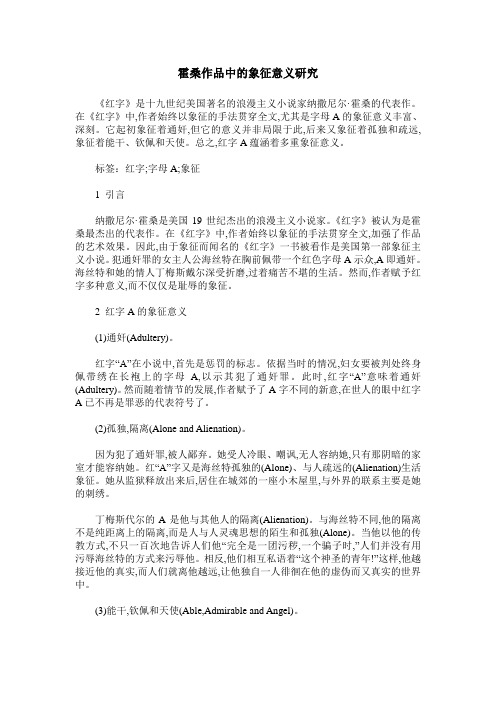
霍桑作品中的象征意义研究《红字》是十九世纪美国著名的浪漫主义小说家纳撒尼尔·霍桑的代表作。
在《红字》中,作者始终以象征的手法贯穿全文,尤其是字母A的象征意义丰富、深刻。
它起初象征着通奸,但它的意义并非局限于此,后来又象征着孤独和疏远,象征着能干、钦佩和天使。
总之,红字A蕴涵着多重象征意义。
标签:红字;字母A;象征1 引言纳撒尼尔·霍桑是美国19世纪杰出的浪漫主义小说家。
《红字》被认为是霍桑最杰出的代表作。
在《红字》中,作者始终以象征的手法贯穿全文,加强了作品的艺术效果。
因此,由于象征而闻名的《红字》一书被看作是美国第一部象征主义小说。
犯通奸罪的女主人公海丝特在胸前佩带一个红色字母A示众,A即通奸。
海丝特和她的情人丁梅斯戴尔深受折磨,过着痛苦不堪的生活。
然而,作者赋予红字多种意义,而不仅仅是耻辱的象征。
2 红字A的象征意义(1)通奸(Adultery)。
红字“A”在小说中,首先是惩罚的标志。
依据当时的情况,妇女要被判处终身佩带绣在长袍上的字母A,以示其犯了通奸罪。
此时,红字“A”意味着通奸(Adultery)。
然而随着情节的发展,作者赋予了A字不同的新意,在世人的眼中红字A已不再是罪恶的代表符号了。
(2)孤独,隔离(Alone and Alienation)。
因为犯了通奸罪,被人鄙弃。
她受人冷眼、嘲讽,无人容纳她,只有那阴暗的家室才能容纳她。
红“A”字又是海丝特孤独的(Alone)、与人疏远的(Alienation)生活象征。
她从监狱释放出来后,居住在城郊的一座小木屋里,与外界的联系主要是她的刺绣。
丁梅斯代尔的A是他与其他人的隔离(Alienation)。
与海丝特不同,他的隔离不是纯距离上的隔离,而是人与人灵魂思想的陌生和孤独(Alone)。
当他以他的传教方式,不只一百次地告诉人们他“完全是一团污秽,一个骗子时,”人们并没有用污辱海丝特的方式来污辱他。
相反,他们相互私语着“这个神圣的青年!”这样,他越接近他的真实,而人们就离他越远,让他独自一人徘徊在他的虚伪而又真实的世界中。
论《红字》的象征寓意

论《红字》的象征寓意一、本文概述《红字》是19世纪美国作家纳撒尼尔·霍桑的代表作,被誉为美国文学的经典之作。
该小说以波士顿殖民时期的社会背景为舞台,通过女主人公海丝特·白兰的悲惨遭遇和道德挣扎,深入探讨了人性、宗教、社会等复杂问题。
本文旨在分析《红字》的象征寓意,揭示霍桑如何通过象征手法,将小说的主题和深层含义巧妙地融入到故事的各个层面之中。
通过对小说中人物、物品、环境等象征元素的分析,我们能够更好地理解霍桑的创作意图,以及这部作品对后世文学和社会思想产生的深远影响。
二、《红字》的故事梗概《红字》是美国作家纳撒尼尔·霍桑于19世纪50年代创作的一部长篇小说。
作品以17世纪中期清教徒统治下的波士顿为背景,细腻地描写了女主人公海丝特·白兰因通奸罪被判在胸前佩戴象征耻辱的红色“A”字示众,在经历了长期的精神折磨后,仍坚持用道德和爱的力量感化他人,最终赢得人们的尊敬的故事。
海丝特·白兰是一个美丽而坚强的女性,她因与教会长丁梅斯代尔的爱情而犯下了通奸罪。
在那个时代,通奸是一种严重的罪行,不仅会受到法律的惩罚,还会被社会所唾弃。
海丝特被迫在胸前佩戴红色的“A”字,这个“A”字象征着她的耻辱和罪孽。
然而,海丝特并没有向命运低头。
她以坚定的信念和无私的爱,独自抚养着与丁梅斯代尔所生的女儿小珠儿。
她用自己的行动和道德力量,逐渐感化了周围的人,赢得了他们的尊敬和信任。
在这个过程中,她不仅救赎了自己,也救赎了那些曾经伤害过她的人。
教会长丁梅斯代尔是一个复杂的人物。
他一方面深爱着海丝特,另一方面又无法摆脱内心的罪恶感和社会的压力。
他在痛苦和矛盾中度过了自己的一生,最终在得知海丝特已经得到了救赎后,选择了向她坦白自己的罪行,并在悔恨中死去。
《红字》通过海丝特和丁梅斯代尔的故事,探讨了人性、道德、爱情和救赎等主题。
作品以象征手法和细腻的心理描写,展现了人性的复杂性和多面性。
霍桑《红字》中的象征主义解读

霍桑《红字》中的象征主义解读《红字》是美国文学史上的经典之作,霍桑在小说中巧妙运用了许多象征主义手法,使得小说具有深刻的寓意和内涵。
本文将从人物、颜色和场景三个方面对《红字》中的象征主义进行解读。
一、人物方面的象征意义首先,小说中的主人公赛琳娜·普林丝是象征“禁欲性”的代表人物。
她因为私通了教士,而被判穿着“A”字母的红色“罪恶”的标志,过着孤独和困苦的生活。
其次,赛琳娜的丈夫罗杰·查琳是象征“复仇”和“报应”的人物。
他在小说中一直在寻找私通者的身份,最终发现是赛琳娜,并计划复仇。
最后,小说中的教士阿瑟·德米辛是象征“双重性”的人物。
他作为教士,本应该代表着道德和伦理,但却和赛琳娜私通,暴露出他的内心深处的矛盾和欲望。
二、颜色方面的象征意义在小说中,红色是最为显眼的颜色。
它既代表着赛琳娜被判穿着的“A”字母,也代表着罗杰·查琳的心中充满的复仇欲望。
此外,红色还代表了罪恶、欲望和魔鬼等负面的含义。
与红色相反的是黑色,它代表着死亡和悲哀。
小说中描写赛琳娜·普林丝的丧葬,墓碑是黑色的,这象征着她的人生悲惨和不幸。
三、场景方面的象征意义小说中的林景是象征着赛琳娜·普林丝的内心。
在林景中,她和教士阿瑟·德米辛私通,这象征着她内心深处的欲望和矛盾。
而在小说结尾,林景又成为了赛琳娜离开世界的场所,这象征着她生命的终结和悲哀。
此外,在小说中还有许多细节的描写,如花草、阳光、天空等,都是象征着不同的含义,寓意深刻。
总之,霍桑在《红字》中运用了众多的象征主义手法,将人物、颜色和场景等元素有机地融合在一起,使得小说具有了深刻的内涵和寓意。
读者通过对这些象征意义的解读和理解,也能更好地领悟小说所表达的思想与精神。
《红字》中的象征意义

《红字》十九世纪美国浪漫主义作家纳撒尼尔崔桑的第一部作品,同时也是他最优秀的作品,这部经典在岁月的洗礼下越发闪耀,先后被译为多种文字,改编成影视作品。
虽然这部作品过去了很多年,但是其中体现出的对爱情、对婚姻以及人性的思考仍然值得我们今天去思考。
作家马原曾说:“《红字》是一部经典已经没有异议。
霍桑是我心中最了不起的小说家。
《红字》与所有别的名著最大的不同,是你可以读它许多遍,每读一遍收获都会有所不同。
它太过短小,涵盖又太过辽阔,这是不可思议的,也几乎是不可能的,但它的确如此。
”再一次重温这部作品,我也有了不一样的感悟,对于作品中的红字也有了更进一步的思考。
接下来我将从红字的罪恶、爱情与救赎三个方面来探究其象征意义。
一、红字之罪恶象征:世俗眼中的伤风败俗首先红字是一个类似字母“A”形状的图案或者标志。
是世俗对主人公赫斯特“婚外情”的惩罚。
当时赫斯特怀孕了,而孩子的父亲却不知是谁,当时的清教与世俗判定其通奸罪行成立,让其终身佩戴红字于胸前作为惩罚。
主人公赫斯特最初因为家庭困难不得已嫁给了比自己年长并且丑陋的老学究罗杰齐灵沃斯,这原本就是一个无爱的婚姻,也许在最开始这个罪恶的种子就已经埋下了。
当时在移居新大陆的时候,罗杰让赫斯特先行一步,但是罗杰却意外被印第安人捉去,这一失踪就是两年,而且隐约传来罗杰死去的讯息。
就是在这个时候,罗杰下落不明,赫斯特好像是一个寡妇的身份,这个时候她与当地年轻帅气又有才气的青年牧师丁梅斯代尔相识,两人经过一段时间的相处顺利相爱了。
后来因为赫斯特怀孕的事情在当地被传开,当时的清教以及世人都认为她犯了通奸之罪,赫斯特在牢狱中生下了他们的爱情结晶——女儿珠儿,可是正是这个时候赫斯特的丈夫罗杰回来了,化身一名医生,躲在黑暗里默默等待报复的时机,悲剧的种子悄悄的长大。
当时法官判定让赫斯特说出奸夫的名字就赦免她,但是她为了维护丁梅斯代尔的名誉,拒绝说出他的名字,最后法官让其终身穿上带有红色“A”字图案的衣服,作为惩罚。
《红字》中的象征意义探讨
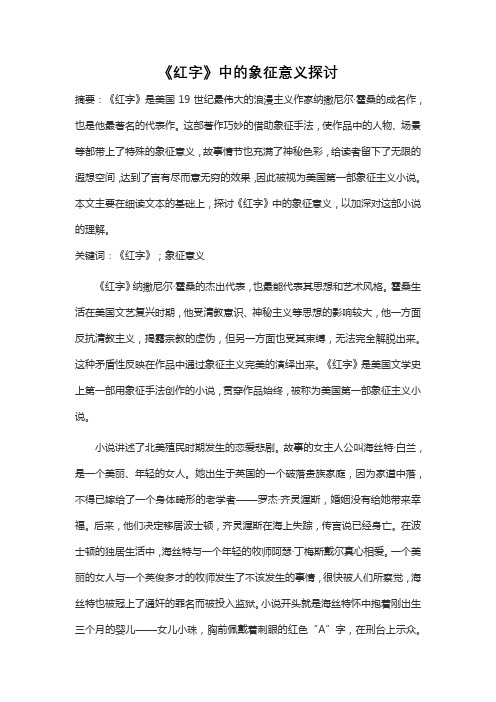
《红字》中的象征意义探讨摘要:《红字》是美国19世纪最伟大的浪漫主义作家纳撒尼尔·霍桑的成名作,也是他最著名的代表作。
这部著作巧妙的借助象征手法,使作品中的人物、场景等都带上了特殊的象征意义,故事情节也充满了神秘色彩,给读者留下了无限的遐想空间,达到了言有尽而意无穷的效果,因此被视为美国第一部象征主义小说。
本文主要在细读文本的基础上,探讨《红字》中的象征意义,以加深对这部小说的理解。
关键词:《红字》;象征意义《红字》纳撒尼尔·霍桑的杰出代表,也最能代表其思想和艺术风格。
霍桑生活在美国文艺复兴时期,他受清教意识、神秘主义等思想的影响较大,他一方面反抗清教主义,揭露宗教的虚伪,但另一方面也受其束缚,无法完全解脱出来。
这种矛盾性反映在作品中通过象征主义完美的演绎出来。
《红字》是美国文学史上第一部用象征手法创作的小说,贯穿作品始终,被称为美国第一部象征主义小说。
小说讲述了北美殖民时期发生的恋爱悲剧。
故事的女主人公叫海丝特·白兰,是一个美丽、年轻的女人。
她出生于英国的一个破落贵族家庭,因为家道中落,不得已嫁给了一个身体畸形的老学者——罗杰·齐灵渥斯,婚姻没有给她带来幸福。
后来,他们决定移居波士顿,齐灵渥斯在海上失踪,传言说已经身亡。
在波士顿的独居生活中,海丝特与一个年轻的牧师阿瑟·丁梅斯戴尔真心相爱。
一个美丽的女人与一个英俊多才的牧师发生了不该发生的事情,很快被人们所察觉,海丝特也被冠上了通奸的罪名而被投入监狱。
小说开头就是海丝特怀中抱着刚出生三个月的婴儿——女儿小珠,胸前佩戴着刺眼的红色“A”字,在刑台上示众。
人们通过多种方式审问、逼迫海丝特说出孩子的父亲到底是谁,但海丝特拒不交代。
在刑台上海丝特看到了混在人群中,两年前被传身亡的丈夫齐灵渥斯。
示众三小时结束后,海丝特因为不交代同犯又被投入了监狱。
海丝特的丈夫来到监狱让海丝特告知他谁是奸夫,海丝特不说,并且告知齐灵渥斯,自己不爱他。
浅析小说《红字》中的人物道德象征

浅析小说《红字》中的人物道德象征小说中,作家分别通过详细刻画海斯特、齐林沃斯、丁梅斯代尔和珠儿,塑造了四种不同形象的人物,不仅给读者留下了深刻的印象,更丰富了世界小说史中的人物。
这四位人物形象,都寓含着深刻的道德含义:海丝特是“善”的道德象征。
她与青年牧师丁梅斯代尔相爱,并犯了通奸罪和生下了珠儿。
虽然作家并非要刻意地宽恕她的罪恶,但他深知与丁梅斯代尔及齐林渥斯所犯下的罪恶相比, 海丝特的罪恶就显得轻得多。
首先, 海丝特是夫权的牺牲品,在年纪尚幼、难辨是非的情况下,丑陋变态、谙于世故的齐林渥斯把她娶占为妻,但却不关心她,更不爱她。
齐林渥斯极其愚蠢且不负责地将一个年轻貌美的女子送往北美大陆的殖民地去孤单地生活,而自己却留在了;在送走妻子之后,齐林渥斯在航行中又成了印第安人的俘虏, 杳无音讯,人们都以为他早已葬身于鱼腹。
此外, 就丁梅斯代尔而言,他明知自己不可能或者说不愿意娶她的情况下,仍让他们之间的恋情不断发展。
更重要的是, 海丝特所犯下的罪过是因爱而引起的,而非蓄意之举,这一点仍有别于齐林渥斯的罪恶。
与此同时,她敢于袒露自己的罪行, 真诚地负罪行善而不是将罪恶隐藏在心中,这一点又将她与丁梅斯代尔截然区别开来。
海丝特从未故意地制造过罪恶,也从未刻意地去伤害他人。
她的不足之处在于,她的爱和激情让她忽视了清教社会中严厉苛刻的道德准则。
正如她所言:“我们所做的事本身就是一种奉献。
我们就是这样认为的! 我们彼此间都这么说过!”虽然她不是清教徒,人们也完全可以怀疑她是否真的遵从清教戒律, 但是,她确实坦然彻底承认了自己的罪孽并勇敢地将它展示在公众面前。
她始终将象征着罪恶与耻辱的红“A”字佩带在胸前,并有意地将“活着的红字”——珠儿的服饰打扮成鲜红色。
她的美德在于诚实, 她在真诚中得到了升华,成了美的象征。
而她的丈夫齐林渥斯则是“恶”的代表。
他与海丝特形成了鲜明的对比。
他的第一个罪恶在于他违反了自然法则。
这个罪恶在他娶回海丝特的那天就犯下了。
- 1、下载文档前请自行甄别文档内容的完整性,平台不提供额外的编辑、内容补充、找答案等附加服务。
- 2、"仅部分预览"的文档,不可在线预览部分如存在完整性等问题,可反馈申请退款(可完整预览的文档不适用该条件!)。
- 3、如文档侵犯您的权益,请联系客服反馈,我们会尽快为您处理(人工客服工作时间:9:00-18:30)。
一、“A”字的象征意义
“A”是字母表中的第一个字母,它意味着开始。
按照基督教的教义来说,开始即堕落,是无人幸免的原罪,或是世界之初的堕落,或是生命之出的堕落。
在这里红字“A”是清教徒惩罚的标志,代表耻辱的通奸罪(Adultery)。
红色是猩红的血,海丝特·白兰(Hester Prynne)胸前的红色“A”字,年轻的牧师阿瑟·狄姆斯台尔(Arthur Dimmesdale)胸前的血字“A”,使人们联想到祭祀台上流着鲜血的羔羊。
霍桑巧妙地把红字贯穿于整个小说,始终让它在不同的地点以不同的形式出现,并赋予不同的意义来表达他的善恶观。
早期对《红字》的研究很多都认为“海丝特·白兰的道德经历了一个从下到上的变化过程”。
这种观点符合霍桑在小说对A 字象征意义的表面解释,即她胸前的红A 字的象征意义经历了“从代表罪恶的通奸到受人尊敬的才能直至表示纯洁和精神的天使的变化过程”。
但事实真的如此吗?自从被迫站在邢台示众后,海丝特·白兰一直过着几乎圣洁的生活:她整年穿着颜色灰暗的衣服;她无私帮助有需求的人而不图回报;在别人注视她胸前佩带的红A 字时,她“谦卑”地低头不语。
这些现象使镇上的居民相信她是真心悔改了。
但是她是真的悔改了吗?其实并非如此。
经过七年认真的“悔改”,海丝特·白兰却决定带着女儿和本牧师一起逃走。
这种表面上看来矛盾和突然的行为是有内在原因的。
虽然白兰为了自己的爱情遭受迫害和侮辱,她却从未屈服,因为她从不认为自己和狄姆斯台尔之间的爱情是错误的,更不用说是罪恶的了。
在森林里,白兰问牧师:“我们的所作所为本
身是一种神圣的贡献。
我们是这样看的!我们在一起说过的!你忘了吗?”[1] 从这番话我们可以断定她对自己的行为并没有后悔过,也从未进行过清教意义上的忏悔。
既然如此,又何从谈起她道德上有一个“自下而上”的飞越呢?从犯通奸罪的妇女变成圣洁的天使只是
她的表面行为给当时镇上居民造成的一种错觉。
因此“A”字的三种象征意义(Adultery;Able ;Angel)也只是代表当时的清教徒对此的理解。
还有,作者的叙述角度是多重的。
他往往从不同人的观察角度来解释评价同一件事情。
比如海丝特·白兰站在邢台上示众的形象,从当时镇上苛责的居民的角度看,她是一个犯了通奸罪的蒙羞的女人;但是如果一个罗马天主教徒看到这幅本画面,则可能把她视为怀抱婴儿的圣母的象征。
对海丝特·白兰而言,红字是佩戴在身上的,是暴露在外面的“罪恶”;对于阿瑟·狄姆斯台尔而言,红字是隐藏在内心的,同样是“罪恶”的象征。
首先他的英文全名是Arthur Dimmesdale ,名字的首字母A 已暗示出红字,而且名与姓的首字母连起来就是AD ,即Adultery(通奸)的前两个字母。
另外,他的名字前半部分Dim意味着dark———黑暗和软弱,而dale 意味valley———山谷,因此象征着牧师内心的灰暗。
他的痛苦完全来自他本人,而不是外界。
他是一个非常虚伪、不诚实的人。
一方面,他没有忠诚于他所信仰的上帝,因为他犯了通奸罪,而长期以来,他是一位虔诚的有名气的牧师,一位受众人尊重的牧师,教民们对他的尊敬和爱戴就像对神灵一般。
这些对他的虚伪本质是重重一击,他一直隐瞒罪恶,但内心极度痛苦,常常捂住胸口,表明红字暗藏心中。
在小说的结尾,牧师终于走上刑台,向世人袒露罪恶,他撕开胸前的衣襟,红字终于显露,此时作者故意含糊其辞地描写到,牧师胸前的红字似乎是为了悔罪而烙上去的印迹,又好像是上帝为了惩罚他而打上的耻辱的标志。
这使得红字有了更加强烈的艺术震撼力,引起读者思想感情上的震动。
可以说,红字含蓄而有力的象征意义,揭示出小说罪与罚的主题。
二、人物的象征意义
《红字》的情节并不复杂,但霍桑在构思和写作上却付出了巨大的心血。
早在1848 年,他就为《红字》框定了主题线索:当可怜的牺牲者被人们践踏在脚下时,胜利者正是充满邪恶情欲的恶魔。
霍桑在这里宣扬的其实是清教徒的“负罪行善”的善恶观。
他认为任何严酷的惩罚和无情的报复都无助于消灭罪恶,唯一有效的方法便是白兰的“认罪—孤立—忏悔—抑恶—行善—回归社会”的苦难历程[2]。
从另一个角度来讲,霍桑小说中的几个主要人物代表了错综复杂的人性的不本同方面。
海丝特·白兰象征着大众所知和略感忏悔的罪人,狄姆斯台尔象征着半悔过的罪人,齐灵渥斯象征着不可原谅的罪人,而珠儿则是未来的,经过充分发展后的完美的人。
整部小说则象征着人性的不同方面之间的纷繁复杂的斗争,人同外在社会伦理道德之间的冲突以及现在与未来之间的冲突。
海丝特·白兰坦然承认罪责,将象征罪恶的红字永远佩戴在胸前。
她热心助人,勤俭度日,最后得以超脱。
她的形象正代表霍桑的观点:面对罪恶,必须诚实,要“把你最坏的东西袒露出来…… 。
”[3]所以白兰代表悔过的罪人,而狄
姆斯台尔则不同,他没有勇气承认罪恶,但内心的负罪感使他倍受折磨、痛不欲生,最终在做完最后一次极富感染力的布道之后,拉着海丝特·白兰和珠儿的手一起走上刑台,露出胸前的红字,在死亡中完成解脱。
狄姆斯台尔经历了由隐瞒到承认罪恶,直到获得灵魂解脱本的过程,所以他代表半悔过的罪人。
小说中另一人物———齐灵渥斯本是受害者,最后变成害人者,代表真正的罪人。
他身体畸形,两眼闪着幽光,脸上现出狰狞的神态。
罪恶的毒液侵蚀了他的灵魂,使他丧失了人性,变得如同魔鬼。
他以医生的身份接近狄姆斯台尔,假装关心,暗中刺探其内心的秘密。
“他像一名探寻黄金的矿工,掘进这可怜牧师的心,或者宁可说,像一个掘墓人掘进一座坟墓。
”[1]对齐灵渥斯而言,生活的全部意义在于追踪仇敌,雪恨复仇。
狄姆斯台尔死后,他的目的达到了,此时“他的全部精力和体力,即他的全部活力和智力,似乎立刻消失殆尽;以致他全然枯萎了、凋谢了,几乎从人的视野里消失了,就像一顶连根拔起的野草在太阳底晒蔫了。
”[1]在霍桑笔下,齐灵渥斯的行为无异于亵渎神灵,比起牧师的罪,他犯了更大的罪,成了真正的罪人。
三、场景的象征意义
《红字》展现了霍桑把握小说结构的高超技巧。
他将小说的开始、中间和结束三个情节焦点均安排在刑台这个高度寓意化的地方,可谓匠心独运。
在小说的开篇,白兰怀抱珠儿、狄姆斯台尔和齐灵渥斯同时到场,其关系为一对奸夫淫妇,两个无辜者。
白兰当本众受辱;狄姆斯台尔暗自心中自责。
第二次是牧师幻想中的示众。
这时各人已朝
各自的归宿迈出了一步,人物的形象亦随之发生了变化:白兰勇敢地面对生活,踏上抑恶扬善的道路;牧师告诉珠儿自己就是她的生父,迈出了认罪的第一步;医生为图报复,已丧失人性,开始走向罪恶。
第三次,即刑台上的最后一幕:牧师公开了自己的罪孽,于临终前片刻使自己的灵魂终于得到解脱;白兰站在邢台上,不过这一次受审的不是她,而是狄姆斯台尔;医生则跪倒牧师旁边,俨如一具僵尸;珠儿从此一改旧习,后来成长为美丽温顺的女子。
这样的安排清楚地勾勒出了故事的三个阶段。
刑台可以说是构成整部小说的框架,同时又从另一个侧面暗示了“罪与罚”的主题。
除了刑台这个主要场景外,其他场景也有各自独特的象征意义,比如监狱和墓地。
由于霍桑小说的主题以揭露人人心中皆有“恶”为主,并且带有神秘主义色彩,所以小说中常常出现监狱和墓地一类的场景。
《红字》以监狱为开篇,以墓地为结束,这两个场景在小说中多次出现。
小说一开始就有这样一段话,“新殖民地的创建者们,不管他们原先计划建立的是什么样的人类美德与幸福的乌托邦,一定会在处女地里圈出一块做墓地;另一块修建监狱”[4],并把监狱比喻成“文明社会的一朵黑花”[5]。
接着齐灵渥斯在监狱里与海丝特白兰碰面,狄姆斯台尔的住处就紧挨着一片坟地,而齐灵渥斯则经常在墓地里采集草药。
可以说在霍桑笔下,监狱和墓地象征着罪恶的滋生地。
小说中还有一个场景本是小溪。
白兰与狄姆斯台尔在溪畔相聚,珠儿在小溪的另一边,任凭白兰怎样呼唤,珠儿怎么也不愿意跨过小溪。
这时敏感的牧师说道:“这条小溪是两个世界的分界线…… 。
(珠儿)是一个不准跨
过小溪的小精灵”[6]。
小溪象征着罪恶与纯洁的分界线。
在森林里,小溪的清澈,蜿蜒点缀着森林的美丽、神秘。
似乎象征着经常在森林中游玩的小珠儿,那纯真、质朴、活泼灵动的自然天性。
它好象没有源头并在阴暗处流淌,那意味珠儿不明的身世。
